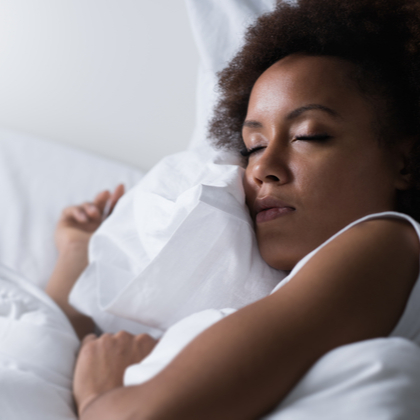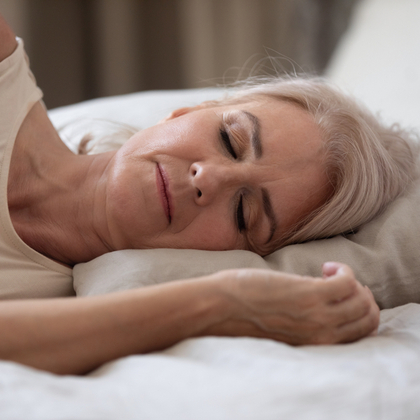
Characterised by sleep attacks, excessive sleepiness, sleep paralysis, hallucinations, and – for a few – cataplexy (the sudden loss of muscle control), narcolepsy is a rare neurological sleep disorder that affects roughly 1 in 2,000 to 3,000 people1.
While there’s no cure for narcolepsy, it can be greatly improved by making lifestyle changes and using management tools. Here, we explore the early signs of narcolepsy and available treatment options.
What are the five signs of narcolepsy?
Since narcolepsy can progress slowly, it often remains undiagnosed for years. But spotting the early signs of narcolepsy can be tremendously helpful in reaching an early diagnosis2. And the sooner the diagnosis, the sooner you can implement the necessary measures to improve the quality of your sleep and wakefulness.

Most individuals with narcolepsy will generally exhibit a few of the symptoms outlined below:3
Excessive daytime sleepiness (EDS)
Narcolepsy may lead to chronic fatigue and sleepiness and/or falling asleep at inappropriate times during the day.4 Excessive daytime sleepiness often compromises productivity, concentration, and short-term memory. Insomnia and night-time disturbances are partly responsible for daytime sleepiness.
Cataplexy
Those with narcolepsy may also experience cataplexy attacks, characterised by temporary involuntary muscle weakness in response to anticipated emotion5. Positive emotions – most notably laughter – and negative emotions – embarrassment, fear, anger, and surprise – are the most likely triggers6.
The severity and length of cataplexy attacks can vary: some people will experience mild jaw drooping; others, however, may fall to the ground completely. The episodes can last anywhere between a few seconds and two minutes.
Sleep paralysis
Sleep paralysis can be another symptom of narcolepsy. These episodes usually occur during REM (rapid eye movement) sleep, either when falling asleep or rousing7. The experience is unusual because individuals are conscious and awake but simply cannot connect to move. Frightening hallucinations may also accompany sleep paralysis.
Hypnagogic hallucinations
Individuals with narcolepsy may also have hypnagogic hallucinations – scary, vivid dream-like experiences during the shift between sleep and wakefulness8. Often, these hallucinations occur alongside sleep paralysis. Most of the content is visual. However, other senses can be involved, too.
Insomnia
Although people with narcolepsy can feel extremely fatigued throughout the day, it’s not uncommon for them to experience insomnia and trouble sleeping through the night9. Individuals with narcolepsy may rouse several times each night – perhaps due to vivid dreams or REM sleep behaviour disorder - exacerbating daytime sleepiness.
Aside from the classic five signs of narcolepsy, the condition can also lead to a range of additional symptoms, such as memory problems, headaches, depression and automatic behaviour (continuing an activity without having any memory of it afterwards)10.
What triggers narcolepsy?
Experts believe there may be several reasons why narcolepsy develops. For individuals suffering from narcolepsy and cataplexy, it’s hypothesized that a lack of the brain chemical hypocretin – which promotes wakefulness and regulates sleep – may be responsible for triggering the condition11. Indeed, hypocretin levels are usually healthy in people who have narcolepsy without cataplexy.
Though the root cause of narcolepsy isn’t fully understood, existing research suggests it may result from a combination of factors that work together to reduce hypocretin levels in the body, which may include: 1213
-
Major psychological stress
-
Hormonal changes during puberty or the menopause
-
An infection, like streptococcal infection or swine flu
-
Autoimmune disorders
-
An inherited genetic fault
-
A sudden change in sleep patterns
What are the treatment options for narcolepsy?
While there’s no specific cure for narcolepsy, you can certainly manage the symptoms and reduce their effect on your daily life. Prioritising your sleep hygiene and making appropriate lifestyle changes can be particularly helpful14.
Establish good sleep hygiene
To minimise excessive daytime sleepiness and promote quality sleep at night, try to establish good sleep hygiene practices.
-
Give yourself a non-negotiable seven to nine-hour sleep opportunity window.
-
Try to go to bed and wake up at the same time every day
-
Keep your bedroom temperate, quiet, dark, and comfortable
-
Refrain from using technology in the 90 minutes before bed
-
Avoid stimulants, like caffeine and nicotine, before bed
Discover more ways to improve your sleep quality and wake up feeling energised here.
Take daytime naps
For many people with narcolepsy, a short nap – no longer than 15-20 minutes – can be refreshing, improving alertness and productivity. Be careful not to nap for too long, however, as it can make it harder to fall asleep at night. Instead, try scheduling a brief nap when you feel sleepiest during the day.
Stay active
Sedentary activities can make anyone feel lethargic and sluggish – and this is especially true for those with narcolepsy. Make time for physical activity every day. Even a brief walk can improve energy levels and overall wellbeing.
Avoid heavy meals and sedating medication
Certain medications, including those used for allergies and seizures, are known to exacerbate fatigue. Therefore, it might be an idea to talk to your GP if you take any prescription medication that can lead to drowsiness.
Heavy meals can have a similarly lethargic effect, so you may want to reduce your portion size.
Medication
If your symptoms are more severe, you should discuss the option of medication with your GP. Sometimes your doctor may prescribe a stimulant (dexamphetamine, modafinil, methylphenidate or pitolisant) or antidepressants.
Does caffeine help narcolepsy?
In moderation – and not after 2 pm in the afternoon – caffeine may be a useful addition to prevent excessive daytime fatigue. However, if you take stimulant medication for narcolepsy, it’s wise to exercise caution. Mixing your medication with caffeinated beverages may lead to heart palpitations, jitters, and anxiety, which can be unpleasant.
What happens if narcolepsy goes untreated?
Without the right treatment and management tools, narcolepsy can be isolating, socially disabling, and even very dangerous, especially when driving. If you suspect you may have the early signs of narcolepsy, please speak to your GP, who will be able to advise you on the next steps to take.
Although narcolepsy can impact almost all aspects of daily life, reassuringly, there are plenty of ways to manage symptoms and allow you to lead a full life.
To learn more about improving your sleep quality, explore the rest of our sleep health hub.
References:
- Sleepfoundation.org. (2021). What is Narcolepsy? National Sleep Foundation. [ONLINE] Available at: https://www.sleepfoundation.org/narcolepsy/what-narcolepsy
- Narcolepsy.org.uk. (2021). How is narcolepsy diagnosed? Narcolepsy UK. [ONLINE] Available at: https://www.narcolepsy.org.uk/resources/how-narcolepsy-diagnosed
- Narcolepsy.org.uk. (2021). What is narcolepsy? Narcolepsy UK. [ONLINE] Available at: https://www.narcolepsy.org.uk/resources/what-narcolepsy; The Sleep Council. (2019). What is Narcolepsy? - The Sleep Council. [ONLINE] Available at: https://sleepcouncil.org.uk/sleep-hub/narcolepsy/
- Sleepfoundation.org. (2021). Excessive Daytime Sleepiness National Sleep Foundation. [ONLINE] Available at: https://www.sleepfoundation.org/narcolepsy/symptoms/excessive-daytime-sleepiness
- Sleepfoundation.org. (2021). Cataplexy National Sleep Foundation. [ONLINE] Available at: https://www.sleepfoundation.org/narcolepsy/symptoms/cataplexy
- Narcolepsy.org.uk. (2021). Cataplexy Narcolepsy UK. [ONLINE] Available at: https://www.narcolepsy.org.uk/resources/cataplexy
- Solomonova, E., Nielsen, T., Stenstrom, P., Simard, V., Frantova, E. and Donderi, D. (2008). Sensed presence as a correlate of sleep paralysis distress, social anxiety and waking state social imagery. Consciousness and Cognition, 17(1), 49-63.
- Healthysleep.med.harvard.edu. (2021). Symptoms Narcolepsy. [ONLINE] Available at: http://healthysleep.med.harvard.edu/narcolepsy/what-is-narcolepsy/narcolepsy_symptoms#Hallucinations
- Ninds.nih.gov. (2021). Narcolepsy Fact Sheet National Institute of Neurological Disorders and Stroke. [ONLINE] Available at: https://www.ninds.nih.gov/Disorders/Patient-Caregiver-Education/Fact-Sheets/Narcolepsy-Fact-Sheet [Accessed 3 Sep. 2019].
- nhs.uk. (2021). Narcolepsy - Symptoms. [ONLINE] Available at: https://www.nhs.uk/conditions/narcolepsy/symptoms/
- Ninds.nih.gov. (2021). Narcolepsy Fact Sheet National Institute of Neurological Disorders and Stroke. [ONLINE] Available at: https://www.ninds.nih.gov/Disorders/Patient-Caregiver-Education/Fact-Sheets/Narcolepsy-Fact-Sheet
- Ninds.nih.gov. (2021). Narcolepsy Fact Sheet National Institute of Neurological Disorders and Stroke. [ONLINE] Available at: https://www.ninds.nih.gov/Disorders/Patient-Caregiver-Education/Fact-Sheets/Narcolepsy-Fact-Sheet
- nhs.uk. (2021). Narcolepsy - Causes. [ONLINE] Available at: https://www.nhs.uk/conditions/narcolepsy/causes/
- Healthysleep.med.harvard.edu. (2021). Self-Care Narcolepsy. [ONLINE] Available at: http://healthysleep.med.harvard.edu/narcolepsy/treating-narcolepsy/self-care
Related Posts

Olivia
Olivia Salter has always been an avid health nut. After graduating from the University of Bristol, she began working for a nutritional consultancy where she discovered her passion for all things wellness-related. There, she executed much of the company’s content marketing strategy and found her niche in health writing, publishing articles in Women’s Health, Mind Body Green, Thrive and Psychologies.
View More



